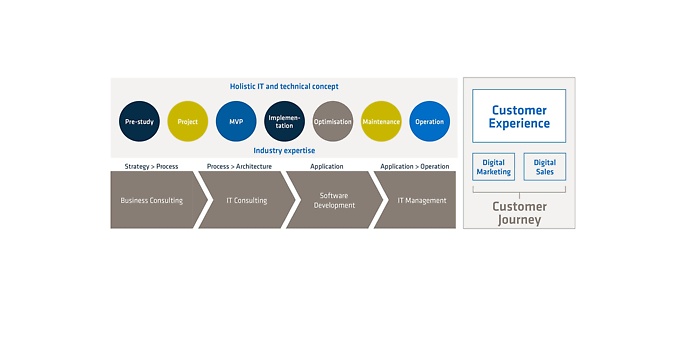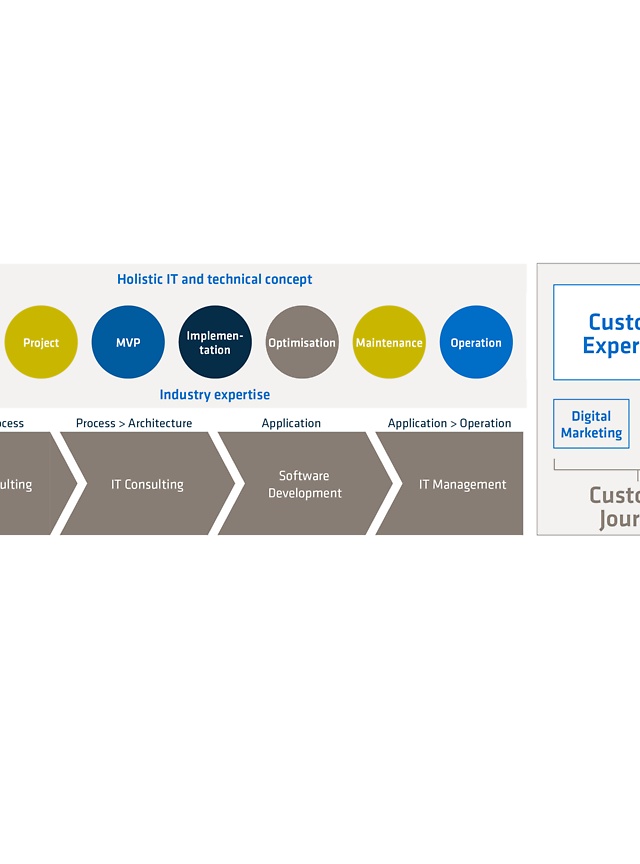18. January 2022 By Nehir Safak-Turhan
Legacy modernisation: how the core banking systems are brought up to the latest digital standards
Faster, more innovative and more digital: this is the success plan of many financial institutions in acknowledgement of the changes in banking currently. Among the key success factors are meeting new customer demands with innovative technologies, offering any time, any place availability as a bank across all channels and having a holistic view of customer needs through an intelligent data strategy. An efficient and flexible design of the IT systems is the basic prerequisite for high-performance banking operations. These ambitions become a Herculean task in view of the outdated IT systems from the last two or three decades.
Initial situation: complex, rigid IT systems and lack of integration
A successful transformation often fails because complex and rigid IT systems are an obstacle to agile and rapid adaptation. It is hardly possible to comprehensively and efficiently digitalise existing core processes on the basis of outdated, organically grown IT systems – some of which have been in use for 20 years – anymore. Much of this has been developed in-house and is based on old programming languages such as PL/I or COBOL, which the new generation of computer scientists are hardly ever taught. Which is why optimisation of the IT systems is only possible to a limited extent due to the limited availability of suitable skills, and correspondingly small is the margin for manoeuvre in standardising and further developing the core systems.
Numerous legacy systems have grown organically over the years through consolidations and mergers in the banking world – without integration and standardisation having ever taken place. The consequences are a multitude of isolated solutions that function on their own yet are not sufficiently integrated, and silo landscapes with inflexible interfaces between the individual applications. Together with the high complexity of monolithic systems, the heterogeneity of the system landscapes cause friction losses and result in cost and process inefficiencies. For example, flexible adjustments and desirable improvements are made more difficult and the smooth exchange of data for fast process handling in banking operations is hindered.
Challenge: reduce poor data quality and barriers to innovative business models
Another characteristic of legacy systems is the lack of uniform data quality, especially due to the multiple storage of data sets (customer data) in numerous legacy silos existing in parallel, and discrepancies can be observed. Eliminating them would mean high consolidation efforts and coordination work. This represents a considerable hurdle for the realisation of innovative business models based on intelligent data use, such as for personalised offers. This is because outdated legacy systems make it difficult to get a comprehensive, holistic view of consistent data sets in real time and thus prevent the necessary transparency and data quality that are essential for intelligent data use.
All in all, outdated IT systems hamper the agile design of work processes and the successful transformation into the digital era. The insufficient customer experience, long and inflexible time-to-market cycles in product management and a lack of digital offerings are just some of the negative effects. At the same time, the lack of uniform, modern IT systems proves to be a disadvantage for the implementation of regulatory requirements and the individual design of change processes.
Vision: modernised core banking systems that are dynamic, highly flexible and profitable
Agility and flexibility are the new success factors for rapid adaptation and the ability to act. This credo also remains valid for the transformation of outdated legacy systems: An individual roadmap that takes into account the specific challenges and goals of the company helps banks define the basis for a successful modernisation of their systems, processes and IT infrastructure.
The modernisation of current IT systems requires patience and a holistic approach that reconciles business advantages, transparent customer benefits and conformity with regulatory requirements in the long term. At the same time, it requires high investments, ties up resources and involves risks, which absolutely need to be taken into consideration beforehand. Traditional transformation projects through a process of cascading, which take several years and only allow for dynamic adjustments to a limited extent, are therefore not very advantageous. These projects often involve high costs and investments – the amortisation of which only becomes apparent at the end of the transformation process and with a bit of a delay. The lack of flexibility in the approach poses a business risk.
As mission-critical parameters, it is therefore critical to analyse the individual need for optimisation and determine the benefits of the measures before starting a modernisation project. A flexible modernisation strategy that supports timely adjustments can use agile methods (Scrum, Kanban) and milestones to ensure quick insights and a sense of achievement without straining implementation speed and risk liability.
Solution: legacy modernisation with IT as the key discipline
A holistic modernisation approach involves not only the modernisation of IT systems, architectures and applications, but ideally also includes innovative forms of work and organisation, agile development processes, and a continuous improvement and optimisation process of the overall organisation. In this manner, modernisation is not limited to the technical infrastructure of a bank, but manifests itself as a part of the corporate culture. The role of IT is of central importance and significantly determines the success of the company: efficient processes, smooth transactions, fast implementation of customer needs, positive customer experiences, the identification and management of risks, as well as the implementation of regulatory requirements are no longer conceivable without high-performance IT.
Best practices on the path to the digital transformation of core banking systems
Every bank is unique and its need for modernisation is just as unique. Nevertheless, there are proven methods that provide best practice approaches:
- Definition of a goal-oriented, flexible modernisation strategy – customer benefits, corporate success and regulatory compliance as central components of the modernisation strategy. Definition of mission-critical parameters such as target architecture (enterprise architecture), technical organisational measures (TOM), budget and resource planning, and so on as a framework for action.
- Cascading of modernisation strategy and realisation of individual intermediate goals – definition and implementation of quickly realisable, manageable steps and quick wins (such as enterprise components for product management, pricing and customers). Pragmatic approach and prompt realisation of partial successes.
- Agile and benefit-oriented approach – DevOps, Scrum, Kanban and agile transition as innovative methods and tools of transformation
- New technologies facilitate the implementation of the transformation – banks can implement their individual modernisation in a targeted manner with cloud computing, microservices, standard solutions, digital workplaces, API management systems, and much more
- Advantages through cooperation and collaboration – IT partners, fintech solutions or innovative business models offer diverse options for modernisation
- Holistic modernisation approach as part of the organisational culture – IT, processes, systems, customer channels, communication and New Work
Conclusion:
Functioning, modern IT systems form the basis for efficient banking operations and a customer-oriented transformation in the banking world. Outdated legacy systems are a key barrier and require the modernisation of inefficient, rigid systems. Even though the modernisation of IT is a major challenge, a benefit and customer-oriented modernisation of the IT landscape is a mandatory prerequisite for more efficiency, customer orientation and future viability of the banks.
What exactly does a transformation of the system landscape in the banking world look like? We are happy to answer questions about our approach and provide information about current project experiences.

The adesso approach: the holistic expertise in IT and technology, paired with many years of industry expertise in the banking sector.
Last year, we surveyed the banking sector on the current status of their transformation activities and the state of their system landscape.
You can find more exciting topics from the adesso world in our blog articles published so far.


